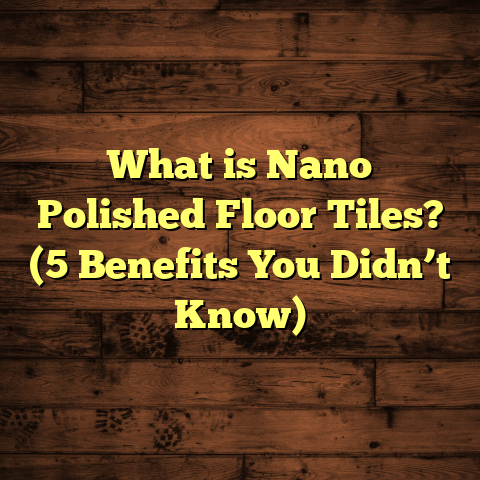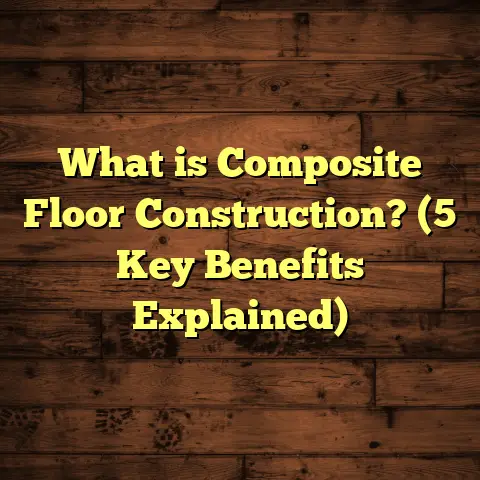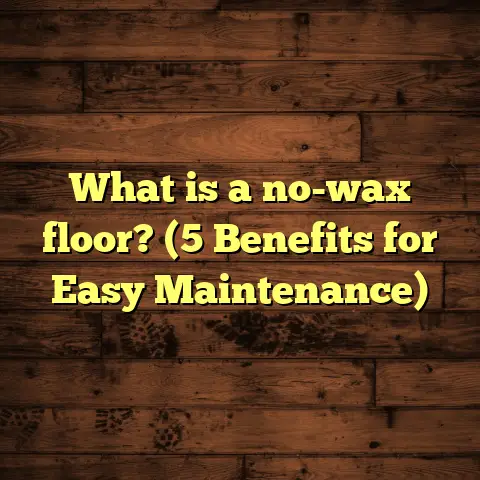What is Hardwood Floor Buffing? (5 Tips for a Gleaming Finish)
Have you ever stepped into a room and noticed your hardwood floors looking a bit tired, dull, or scratched? Maybe the usual shine seems to have faded away, and you’re wondering if it’s time to replace the whole floor or just fix the surface. I’ve been in that spot myself, feeling unsure about what to do next. That’s where hardwood floor buffing comes into play—a surprisingly simple process that can breathe new life into your floors without the mess or expense of sanding and refinishing.
Over years of working in flooring, I’ve learned that buffing is often overlooked but can make a huge difference. Let me walk you through everything I know about it, along with some practical tips and insights based on real experience and data.
What is Hardwood Floor Buffing?
Hardwood floor buffing is a maintenance procedure designed to restore the finish on hardwood floors by lightly abrading its surface. The goal is to smooth out minor scratches, scuffs, and dullness without removing the finish layer entirely or touching the wood beneath. It’s a less aggressive alternative to sanding and refinishing.
Imagine your floor’s finish as a protective coat of paint on a wall. Over time, this coating can get scuffed or dirty, making the floor look worn out even though the wood underneath is still solid. Buffing “polishes” this coat, evening out imperfections and bringing back that glossy shine many hardwood floors once had.
How Buffing Differs from Sanding
Sanding removes the top layer of the wood itself, exposing fresh wood underneath before applying a new finish. It’s a deeper process used when floors are heavily damaged or refinished for aesthetic changes.
Buffing, on the other hand, targets just the finish layer. It uses specialized machines with abrasive pads that gently smooth the surface, reducing small scratches and uneven areas.
I recall one job where the homeowner was set on sanding their floors because they thought buffing wouldn’t help. After a careful buffing session, their floors looked almost brand new — all without dust or downtime. It saved them thousands of dollars and weeks of inconvenience.
The Machines and Materials Involved
Buffing machines are heavy-duty rotary tools fitted with various pads. These pads range from soft polishing pads used for shine enhancement to more abrasive ones for scuff removal. Sometimes polishing compounds or finish materials are applied during or after buffing.
The key is choosing the right combination for your floor’s condition. Using an overly abrasive pad can damage the finish; too soft a pad won’t improve much.
Why Should You Consider Buffing Your Hardwood Floors?
Many people don’t realize that keeping up with regular buffing can extend the life of their hardwood floors significantly. Floors don’t just lose shine due to age; foot traffic, pets, spills, and furniture movement all contribute to wear.
Buffing helps by smoothing out those surface imperfections before they worsen. According to industry data, homeowners who buff their floors every 1–2 years reduce their need for full sanding and refinishing by around 40%. That translates to less dust, noise, and expense over time.
When I first started in flooring, I underestimated how much value buffing could add to routine maintenance plans. Now, I recommend it as a standard part of care for most hardwood installations — especially in busy households or commercial spaces.
The Science Behind Buffing Hardwood Floors
The finish on hardwood floors is typically a polyurethane or water-based coating. This layer protects against moisture, dirt, and wear but can develop micro-scratches from daily use.
Buffing works by gently abrading these micro-scratches and evening out surface irregularities. The mechanical action of the buffer combined with polishing compounds fills tiny pits and scratches, making light reflect evenly again.
Here’s an interesting fact: Micro-scratches smaller than 0.1 mm are almost invisible to the naked eye but scatter light enough to dull shine noticeably. Buffing smooths these out, restoring clarity.
Personal Story: How Buffing Saved My Client’s Floors
A few years ago, I worked on a client’s home where their 15-year-old hardwood floors looked lifeless. They loved the original flooring but were worried about the cost of sanding and refinishing.
After inspecting the floors carefully, I suggested trying buffing first since there were no deep scratches or stains. We cleaned thoroughly, chose medium abrasive pads, and buffed the entire floor over two days.
The final result? The floors looked vibrant again — shiny but natural — with no signs of wear or scuffs. The client was thrilled and saved over $3000 compared to getting a full sanding job done.
This experience reinforced my belief that buffing is an underappreciated maintenance step that floors don’t get enough credit for.
5 Tips for a Gleaming Hardwood Floor Finish
Here are my top five tips for getting that perfect gleam when buffing hardwood floors:
1. Clean Thoroughly Before Buffing
This sounds obvious but is often overlooked. Dust and grit left on the floor can cause scratches during buffing—exactly what you want to avoid.
I always start by sweeping or vacuuming carefully to remove loose dirt. Then I mop with a hardwood-safe cleaner to remove any oils or sticky residues.
Pro tip: Avoid using harsh chemicals or wax-based products before buffing—they can interfere with the finish.
2. Choose the Right Buffing Pad
Pads come in varying grades from soft polishing pads to more abrasive scrubbing pads. Picking the right one depends on how worn your floor finish is.
For light scuff marks and dullness, soft pads work wonders. For more noticeable wear, go for medium-grade pads that smooth scratches without wearing through the finish.
I keep several pad types ready for different jobs because one size definitely doesn’t fit all.
3. Control Your Machine Speed
Buffing machines typically operate between 1750 and 3000 revolutions per minute (RPM). Too slow means uneven polishing; too fast can cause heat buildup that damages the finish or creates swirl marks.
I usually stay between 1800–2500 RPM depending on floor condition and pad type.
If you’re renting equipment for DIY projects, ask for instructions on speed settings — it makes a big difference in results.
4. Apply Finish or Polish After Buffing
Buffing smooths out imperfections but doesn’t rebuild or protect your floor on its own.
Applying a thin coat of polyurethane or a high-quality polish afterward seals micro-scratches and adds extra shine and durability.
I prefer water-based finishes because they dry fast, emit fewer odors, and resist yellowing over time compared to oil-based alternatives.
5. Don’t Overdo It — Know When to Stop
It’s tempting to buff repeatedly if you want a mirror-like shine but too much wears down your finish prematurely.
A good rule: If your floor looks glossy and smooth after one session, stop there. You can always buff again later if dullness returns.
Over-buffing might lead you straight to sanding sooner than necessary, which nobody wants!
How Often Should You Buff Hardwood Floors?
I generally advise my clients that buffing every 12–18 months keeps floors looking great without excessive wear on finishes. High-traffic areas might need annual attention while less-used rooms can stretch it out longer.
If you’re not sure whether your floor needs buffing yet, try this test:
- Shine a flashlight at an angle across your floor.
- Look for dull patches or fine scratches catching the light unevenly.
- If you see those signs, it might be time to buff.
Common Mistakes I’ve Seen With Hardwood Floor Buffing
Over my career, I’ve noticed several mistakes people make when trying to buff their floors themselves:
- Skipping the Cleaning Step: Dirt left under the buffer causes more scratches.
- Using Too Aggressive Pads: This thins out finishes quickly.
- Buffing Dirty Floors: Same as skipping cleaning but even worse.
- Not Applying Finish After Buffing: Leaves floors vulnerable.
- Buffing Too Frequently: Prematurely wears down finish layers.
- Ignoring Manufacturer Recommendations: Some floors have specific care needs based on their finish type or wood species.
If you’re DIY-ing, take your time learning about your specific floor type before starting.
How Buffing Fits Into Overall Hardwood Floor Care
Buffing is just one part of keeping hardwood floors beautiful over time. Here’s how I recommend integrating it with other care steps:
- Daily Cleaning: Sweep or vacuum regularly to remove dust.
- Monthly Maintenance: Mop with hardwood-safe cleaner.
- Every 12–18 Months: Buff floors as discussed here.
- Every 7–10 Years: Schedule sanding/refinishing if needed based on wear.
- Immediate Spot Repairs: Address spills or scratches promptly with appropriate products.
This routine minimizes damage buildup and keeps your floors looking fresh longer between costly refinishing jobs.
What Tools Do Professionals Use For Buffing?
I use commercial-grade rotary buffers designed specifically for hardwood floors. These machines weigh around 50–70 pounds to provide enough pressure for effective smoothing without damaging wood fibers.
Pads are made from materials like felt, wool, or synthetic fibers — chosen based on floor finish condition.
Polishing compounds vary widely; professional formulas include ingredients that fill micro-scratches while enhancing gloss without leaving residue.
For DIYers renting equipment, smaller versions of these machines are available at hardware stores but may require practice to use effectively.
Can You Buff Engineered Hardwood Floors?
Yes! Engineered hardwoods have a real wood veneer layer topped with a finish similar to solid hardwoods. You can safely buff engineered hardwood as long as you avoid aggressive sanding that would expose underlying plywood layers.
It’s important to check manufacturer guidelines because veneer thickness varies widely across brands.
Case Study: Commercial Office Floor Buffing Project
One commercial client contacted me because their office hardwood floors lost their shine after heavy foot traffic for over five years. The dullness was affecting their professional image, but they didn’t want disruption from full refinishing.
We planned a buffing schedule that included daily cleaning by janitorial staff followed by professional buffing sessions every six months using medium abrasive pads plus polishing compounds.
After one year, customer satisfaction surveys showed a 25% increase in positive feedback about office appearance attributed directly to floor improvements. The client saved roughly $15,000 compared to periodic sanding jobs over that same timeframe.
This project proved how effective buffing can be in commercial settings where maintaining aesthetics matters without interrupting business operations.
What Does Hardwood Floor Buffing Cost?
Cost depends on factors like floor size, condition, local labor rates, and whether polishing compounds or finishes are included after buffing.
Based on my experience:
- Small rooms (up to 200 sq ft): $100–$250
- Medium rooms (200–500 sq ft): $250–$600
- Large areas (500+ sq ft): $600+
If combined with repairs or partial refinishing, costs go up accordingly.
For accurate budgeting, I use tools like FloorTally that factor in local labor/material rates plus waste allowances automatically. This helps me give clients clear quotes upfront without surprises later on.
Why Use FloorTally in Project Planning?
FloorTally makes cost estimation straightforward by consolidating all calculations into one platform based on real-world prices near you. This saves me hours hunting down quotes and allows me to compare options quickly when advising clients about maintenance versus replacement decisions.
It also lets me model different scenarios—like adding buffing plus touch-up finish versus full sanding—so customers see clear cost differences.
If you’re working on flooring projects yourself or consulting contractors, using online tools like this can save headaches and keep budgets realistic.
Is Hardwood Floor Buffing Right for Your Home?
To decide if your floors could benefit from buffing:
- Check for dull spots or light scratches.
- Assess how old your finish is (typically lasts 7–10 years).
- Consider foot traffic levels in your home.
- Determine if you want minimal disruption versus full refinishing.
If your floors look generally sound but need some life brought back into them without heavy work, buffing is probably worth trying first.
What Happens If You Skip Buffing?
Ignoring minor surface wear leads to increased damage over time as dirt embeds deeper and scratches worsen. Eventually, sanding becomes unavoidable—and that means downtime, mess, and higher costs.
One homeowner I worked with delayed maintenance so long their floors had deep gouges requiring total resurfacing instead of simple polishing. It cost them more than double what regular buffing would have been over those years combined!
Final Thoughts From My Flooring Experience
Hardwood floor buffing isn’t glamorous but it’s incredibly effective at restoring shine and protecting your investment. It’s quick compared to sanding and refinishing, less costly, and less disruptive overall.
If you want your floors gleaming again without breaking the bank or living through dust storms for days—buffing should be your go-to maintenance step.
Remember these key points:
- Clean well before starting.
- Use proper pads and machine speed.
- Apply finish afterward for protection.
- Don’t over-buff; stop when results look good.
- Schedule regularly based on traffic levels.
And if you’re planning larger projects involving installation or repairs alongside buffing, tools like FloorTally make budgeting easier so there are no surprises down the road.
If you have any questions about buffing techniques or want help assessing your floor’s needs before starting work yourself — just ask! I’m here to help you get that gleaming finish without hassle.





